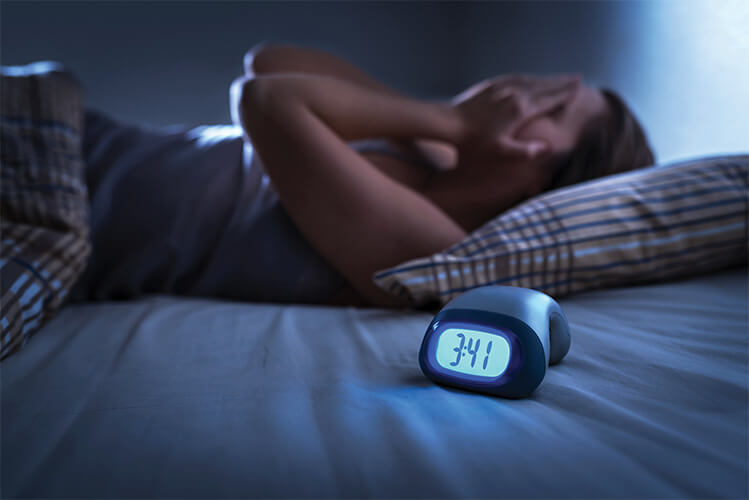In today’s world there are many ways to fend off tiredness and put off the urge to sleep, but there is a growing body of evidence that suggests sleep disruption could be severely damaging to our physical and mental health
Most of us know the restorative value of an early night, so on some level we instinctively understand that sleep is good for both the body and the mind. Now, a growing body of research is starting to show just how vital sleep is to our overall health and longevity. Some believe that laughter is no longer the best medicine—sleep is.
New research from Monash University in Australia has shown that irregular sleep is strongly linked to a higher risk of death over a seven-year period. Without set times for sleeping and waking, we are playing fast and loose with physiological and psychological processes that could impact our health. Furthermore, it is not only our sleep patterns, but also the quality of sleep and, perhaps, our ability to dream that defines our physical and mental health.
Monash researchers used 88,975 participants from the prospective U.K. Biobank cohort and found that irregular sleep disrupts circadian rhythms—endogenous cycles in physiological, hormonal, and behavioral processes largely synchronized to the external 24-hour light/dark cycle. This increases the risk of several chronic age-related diseases, including cardiovascular disease (CVD), as well cancer mortality. The health impacts of irregular sleep/wake timing are still emerging because many changes in human sleep patterns are relatively recent. Indeed, the study notes that “modern societal and lifestyle trends, including exposure to artificial and blue light at night, longer work hours, shift work, and the 24/7 lifestyle, have blurred the distinction between day and night, increasing the propensity for circadian disruption.”
The human species once had a very different relationship to sleep. Historian A. Roger Ekrich drew on sources from ancient and medieval literature to argue that before the Industrial Revolution, interrupted sleep was dominant in Western civilization. He proposed that adults typically slept in two phases, with a gap of one hour in between that could be used for prayer and reflection. Now, sleep is compressed into a short period, while we are fed the lie that everyone needs eight hours of uninterrupted sleep.
“In the preindustrial era, sleep was intuitively embraced,” says Professor Russell Foster, professor of circadian neuroscience at Oxford University and Director of the The Sir Jules Thorn Sleep & Circadian Neuroscience Institute (SCNi). “From the 1950s, there was an invasion of the night, eroding opportunities to sleep and pouring more activity into an overpacked day. In the 1980s, sleep was seen as an enemy that needed to be wrestled with and defeated, but now we understand the value of it.”
“Around 30% of problems doctors see are a result of poor sleep,” he continues. “Sleep is a variable part of our biology, and there is a lot of misinformation out there, which has led to an explosion of sleep anxiety. Sleep duration varies with age and between individuals.”
So, could sleep be the next wild frontier in health and wellbeing for the modern age?
“Our sleep and wake patterns are influenced by clocks within our bodies, and when our patterns are irregular, such as when we change our sleep schedules at the weekend, this can result in a lack of synchrony between our internal body clocks and the world around us,” says one of the U.K.’s leading sleep experts, professor of psychology Alice Gregory of Goldsmiths, University of London. “Certain challenges may result, including difficulties falling asleep and performing well at work when we have to wake up early.”

Unrested and unwell
Many studies have examined the link between poor sleep quality and health. A 2021 paper by researchers in Brazil [1], for instance, examined poor sleep quality, excessive daytime sleepiness (EDS) and association with mental health in college students, finding that both are associated with moderate and high perceived stress and the presence of depressive symptoms. This echoed results from a 2017 study of U.S. adolescents [2], which found that later weeknight bedtime, shorter weeknight sleep duration, greater weekend bedtime delay, and both short and long periods of weekend oversleep were associated with increased anxiety, substance use, and behavioral disorders, as well as suicidal thoughts, and poor perceived mental and physical health.
The SCNi has dug deep into this issue and found that staying in tune with circadian rhythms seems crucial to optimal health. Suboptimal sleep patterns have been strongly associated with an array of mental disorders and other health-related outcomes in a vast body of research, though sleep and daily rhythms do change profoundly from infancy to advanced adulthood. SCNi’s work also found that sleep and circadian rhythm disruption (SCRD) is a feature shared by some of the most challenging diseases, among them schizophrenia, bipolar disorder, depression, Alzheimer’s, stroke, multiple sclerosis, autism, and serious disorders of the eye.
The institute’s research highlighted that sleep duration shortens as we age, and circadian rhythms become less rigid, which may mean sleep becomes more fragmented. Furthermore, there is a change in our circadian timing, with a tendency to show a later chronotype—the night owl—as we progress through the teenage years and into early adulthood, then shifting increasingly to an earlier chronotype—the morning person—from our twenties into old age.
“We have evolved an internal clock and some things need to be done in an inactive phase,” says Foster. “Sleep is a highly efficient inactive phase. You park information offline and then deal with it while asleep, and you remove toxins built up during the day. In sleep, you do not move around an environment to which you are poorly adapted, so you can perform other functions, such as memory consolidation.”
“If you look at night shift workers, you can see the problems of disrupted sleep patterns,” he adds. “Irritability, loss of empathy, failure to pick up social cues, risk-taking, negative salience—remembering negative experiences and forgetting positive ones—as well as impaired cognition, information processing, and decision-making. It may also lead to stimulant and sedative use, altered stress responses, the development of CVD, the release of hunger hormone ghrelin and a drive to consume carbohydrates,” he adds.
Poor sleep in the middle years of life is also a risk factor for dementia, and in 2007, the World Health Organization classified night shift work as a probable carcinogen due to circadian disruption.
What dreams may come
Much of the health information around sleep currently focuses on duration—what Foster refers to as the eight-hour myth—but sleep is as complex and multilayered as the dreams that emerge in the sleeping brain. Indeed, those dreams may play a vital part in the restorative and health-giving effects of the sleep phase.
“The most recent research suggests that REM sleep, in which the majority of dreams occur, is a state shared across mammals that serves physiological function for neurotransmitter replenishment and body temperature regulation and—at least in the larger-brained mammals—memory consolidation,” says Dr. Deirdre Barrett, Clinical and Evolutionary Psychologist at Harvard Medical School. “But research also suggests that for humans, this different brain state is associated with very different types of thinking about all of our usual interests,” she adds. “The content is much of the same fears, hopes, goals, social settings that we think about awake and that sometimes this different mode of thought gives us a useful novel idea.”
Dreams, it seems, are fundamental to building or changing our map of the world, ourselves, and our experience. No wonder they are believed to have a huge impact on mental health. “There is more research on when dreams can be helpful, but the one definitely negative effect is for PTSD nightmares,” continues Barrett. “They are uniformly reported by the people who have them as retraumatizing.”
She further notes that “research suggests, in addition to simply getting enough sleep, making an effort to recall dreams, sharing them with others, and spending time interpreting what they tell us about our unconscious processes are all reported to be enhancing to people practicing this.” Some dream researchers have also examined the most vivid of dream states: lucid dreaming. In lucid dreams, the dreamer is aware they are dreaming and may be able to develop some level of choice in how they explore the dreamworld.
Researchers at the University of Northampton, among them Head of Psychology and Sociology Dr. David Saunders, have demonstrated that lucid dreamers become more adept at perceiving subtle changes or objects in their visual field when awake. The implication is that lucid dream experiences impact the way we think, solve problems, and relate to others in waking life. Indeed, in the late 1980s, German Gestalt psychologist Paul Tholey proposed that lucid dreams could be used as a therapeutic tool to promote self-healing and growth through conciliatory interactions with threatening dream figures. Removing the dangerous characteristics of a threatening dream figure could, for example, lead to the resolution of unconscious conflicts. More recently, Lucid Dreaming Therapy has demonstrated its effectiveness in helping people to overcome the recurrent nightmares associated with post-traumatic stress disorder (PTSD).
“Regarding physical health, it is a widely researched phenomenon that motor-imagery is an effective and regularly used form of motor-skill refinement for professional sportspeople and musicians, and lucid dreams are an even more immersive experience than imagination,” says Saunders. “The actions you perform within a dream are broadly real, this is why we have downward inhibition of the pontine gateway during REM sleep, to stop us acting out dream experiences.”
“However, performing the actions within a dream can still lead to strengthening of synaptic connections and, it is suspected, refinement of motor skills,” he adds. “Lucid dreaming has been demonstrated to have the potential to help with motor-skill refinement and is suggestive that it may be similarly helpful therapeutically in supporting conventional approaches of motor-rehabilitation.”
Powerful medicine
The impact of sleep on health is undeniable, so the crucial question is how to optimize the quality of sleep. Gregory, who recently published 50 tips aimed at improving sleep quality, has delved into this question, and maintaining a schedule is chief among them. “Sticking to a regular sleep/wake schedule, considering the impact of light on sleep, including avoiding bright light before bed, and ensuring we are not attempting to get more sleep than we actually need are all important,” she says. “It’s wonderful that the public health message that we should not be scrimping on our sleep is finally being heard. However, this shouldn’t be interpreted as the recommendation that we should get as much sleep as we can.”
Too much sleep also has its downsides. Gregory notes that most middle-aged adults will need 7–9 hours a night, and it is very unlikely that any adult would need more than 10 hours. It is essential to understand that one’s optimal sleep patterns will be individual. It is within the grasp of each of us to regulate and define our own sleep patterns, so benefitting from this most powerful and purely endogenous medicine is a process of self-exploration. Although there are many drugs, apps, and contraptions on the market to aid our sleep, the key that unlocks the restorative power of sleep and dreams could simply be the process of getting to know one’s own rhythms.
References
- J. N. Ramos et al., “Poor sleep quality, excessive daytime sleepiness and association with mental health in college students,” Ann. Human Biol., vol. 48, no. 5, pp. 382–388, Aug. 2021, doi: 10.1080/03014460.2021.1983019.
- J. Zhang et al., “Sleep patterns and mental health correlates in US adolescents,” J. Pediatr., vol. 182, pp. 137–143, Mar. 2017, doi: 10.1016/j.jpeds.2016.11.007.



